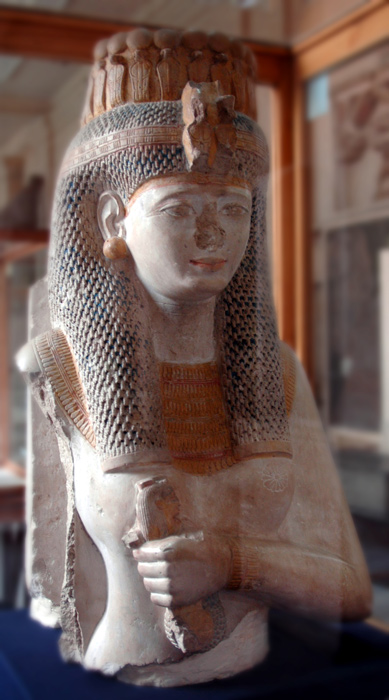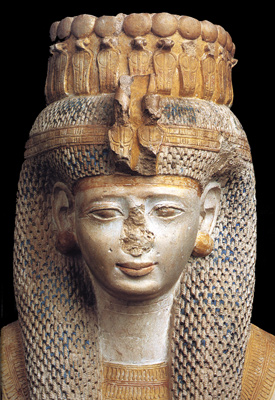-

- Princess Meritamun, "the White Queen"
-
- This statue was discovered in 1896 in a chapel north-west of the Ramesseum in
Thebes. It is master piece of its period and demonstrates the sensitive
nature of the artist.
-
- Even though only the titles, and not
the name of the queen are preserved on the rear pilaster, this
piece has been identified as a statue of Meritamun, one of the
daughters of Ramesses II. On the death of Nefertari (some time
after the 21st year of the Ramesses' reign) she took on the role
of the Great Royal Wife. She was known only a the "White
Queen" until the discovery in 1981 of a colossal statue at Akhmim in Upper Egypt
besides a similar statue of Rameses II at the entrance to the New Kingdom
temple. The Akhmim statue was similar to this statue in epithets and titles and
is inscribed with the name of the princess Meritamon, daughter of Queen
Nefertari and Rameses II. She became Great Royal Wife of Rameses II after
the death of her mother.
-
- The inscriptions say that
Meritamon was the beloved of her lord, the great one of the harem of Amun-Ra, a
musician, a chantress and a dancer of different divinities at Thebes and in
Upper Egypt. Meritamon wears a crown surrounded by a diadem. On her
forehead are two uraei wearing the crown of upper Egypt. She is wearing
earrings, a broad collar and a bracelet. Her Right breast is ornamented
with a rosette and her left hand, resting on her left breast, is holding a
musical instrument, symbol of Hathor (goddess of Beauty, Love and Music).
-
- The painted decoration of the statue is
still very well preserved. The yellow of some of the facial
features and decorative elements combines well with the blue of
the wig, both of which are enhanced by the brightness of the
extremely fine limestone used for the sculpture.
- The face has a serene expression. The
eyes are almond shaped, elongated by a line of cosmetic (shown
by two thin incisions), and set below heavy eyebrows. The full
mouth is set in a slight smile, similar to those seen on a
number of statues of Ramesses II. Thin lines are incised on the
neck. The lobes of the ears are covered by large hemispherical
earrings.
The delicate face is framed by a three-part wig, from which the
natural hair emerges, and is held in place by a diadem featuring
two cobras wearing the White and Red Crowns, the symbols of
Upper and Lower Egypt. On top of her head the queen wears a
circular diadem, its base decorated all the way round with a
frieze of uraei with solar discs. From this base would once have
risen a double plume with a solar disc at the centre, a
prerogative of the Great Royal Brides.
Meritamun wears a tightly fitting tunic. Around her shoulders is
a broad-collar necklace consisting of six rows of beads, five of
which are in the form of small amulets of the hieroglyph
nefer ('beautiful'). The last row consists of drop shaped
beads. A rosette decorates her left breast while the right
breast is covered by the counterweight of the menat
necklace which she is holding in her right hand. On her wrist is
a bracelet composed of two rows of beads.
 The
menat necklace was used as a musical instrument and was
shaken to produce a loud noise on the occasion of the feasts
held in honour of Hathor or other female divinities. The
necklace was composed of numerous strands of beads, balanced
with a large counterweight, in this case in the form of a female
head and ending in a circular element with a rosette.
The
menat necklace was used as a musical instrument and was
shaken to produce a loud noise on the occasion of the feasts
held in honour of Hathor or other female divinities. The
necklace was composed of numerous strands of beads, balanced
with a large counterweight, in this case in the form of a female
head and ending in a circular element with a rosette.
In ancient Egypt taking part in processions, singing, dancing
and playing musical instruments was a typically female
prerogative. Priestesses were frequently indicated with their
specific functions within the train of the divinity and it was
only natural that the queen herself performed a number of these
priestly functions. The fragmentary hieroglyphic inscription on
the dorsal pillar of the statue reads '...player of the sistrum
of Mut and the menat necklace [of Hathor] ...
dancer of Hathor....'.
|